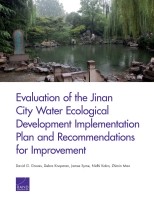| 来源类型 | Research Reports
|
| 规范类型 | 报告
|
| DOI | https://doi.org/10.7249/RR1682
|
| ISBN | 9780833097262
|
| 来源ID | RR-1682-JWRB
|
| Evaluation of the Jinan City Water Ecological Development Implementation Plan and Recommendations for Improvement |
| David G. Groves; Debra Knopman; James Syme; Nidhi Kalra; Zhimin Mao
|
| 发表日期 | 2017
|
| 出版年 | 2017
|
| 页码 | 180
|
| 语种 | 英语
|
| 结论 |
Projected Demand, River Allocations, and Changes in Climate Affect Residential, Industrial, and Agricultural Sectors- Because of data limitations, particularly pertaining to surface and groundwater interactions, model results should be taken as instructive and not definitive.
- All of the downscaled climate projections show warming. However, there is scientific disagreement about whether conditions will be getting wetter or drier. One of the benefits of this analysis is that it helps Jinan officials understand how important this uncertainty is by looking at results across a wide range of wetter and drier conditions. Our study shows that it is not an important factor in most cases.
- Unmet demand in the residential sector is driven more by levels of projected demand and allocation of Yellow River resources than by changes in future climate.
- Under a medium demand projection and full Yellow River allocation, the industrial sector is vulnerable only under an assumption of low initial groundwater storage. Under a 50-percent Yellow River allocation, the industrial sector is vulnerable under all demand projections, regardless of initial groundwater assumptions.
- The vulnerability of the agricultural sector depends on future climate more than the residential and industrial sectors. We see no shortages in the wettest climates but very significant shortages in drier climates.
- Jinan's springs are vulnerable across all futures. Even in wet climates, low spring flows each year occur around three months on average; in dry climates, low flows appear on average about eight months each year.
|
| 摘要 |
- Strategies in the residential sector that include reuse and full implementation of water use efficiency reduce vulnerabilities significantly.
- The industrial sector is more vulnerable than the residential sector. Increasing reuse helps to eliminate unmet demand almost entirely.
- The agricultural sector is less vulnerable than the other sectors, but any measures that reduce irrigation demands in drier climates will be essential. Because agricultural unmet demand is relatively small, as ample surface and groundwater supplies are available in the districts in which agriculture dominates, excess supply could be transferred elsewhere in the system with new conveyance structures.
- All strategies that include the proposed Springs Adaptive Groundwater Management policy reduce the number of months of low spring flow.
- Management of groundwater resources is a key to Jinan's future. More extensive and efficient use of surface water resources to satisfy demands across the sectors will reduce pressure on groundwater.
- Efforts should continue to improve the quality of input data to the Jinan WEAP model. Priority should be given to those parameters that relate to ground- and surface water interactions.
- The Jinan WEAP model should be considered a work in progress and tool for improving understanding of Jinan's complex water management system. We recommend that a single individual be responsible for overseeing model development, maintenance, and operations.
- Consideration should be given for linking the output of a well-calibrated, high-resolution groundwater model to the Jinan WEAP model. This would improve the ability of the Jinan WEAP model to represent surface and groundwater interactions, particularly the behavior of the spring systems.
|
| 主题 | China
; Flooding
; Global Climate Change
; Robust Decision Making
; Water Resources Management
; Water Supply
|
| URL | https://www.rand.org/pubs/research_reports/RR1682.html
|
| 来源智库 | RAND Corporation (United States)
|
| 引用统计 |
|
| 资源类型 | 智库出版物
|
| 条目标识符 | http://119.78.100.153/handle/2XGU8XDN/108464
|
推荐引用方式
GB/T 7714 |
David G. Groves,Debra Knopman,James Syme,et al. Evaluation of the Jinan City Water Ecological Development Implementation Plan and Recommendations for Improvement. 2017.
|
|
文件名:
|
x1495297060252.jpg
|
|
格式:
|
JPEG
|

|
文件名:
|
RAND_RR1682.pdf
|
|
格式:
|
Adobe PDF
|
此文件暂不支持浏览
除非特别说明,本系统中所有内容都受版权保护,并保留所有权利。